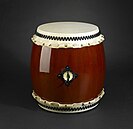Our website is made possible by displaying online advertisements to our visitors.
Please consider supporting us by disabling your ad blocker.
Wikipedia:Today's featured article/April 14, 2015
Taiko drums, a broad range of Japanese percussion instruments, were introduced to Japan through Korean and Chinese cultural influence as early as the 6th century, and a mythological origin is mentioned in the Nihon Shoki, the second oldest book of Japanese classical history. They have seen use in Japan for communication, theatre, religious ceremonies, and festival and concert performances. In feudal warfare, taiko drums were used to summon troops, call out orders and set a marching pace. In modern times, they have played a role in social movements for minorities within and outside Japan. Taiko performances can vary in their rhythms, forms, stick grips, clothing, and instrumentation. Ensembles typically use different types of barrel-shaped nagadō-daiko drums, as well as the smaller shime-daiko. Many groups accompany their drums with vocals, strings, and woodwind instruments. The popular ensemble style called kumi-daiko was developed in 1951 through the work of Daihachi Oguchi, and has continued with groups such as Kodo. Kumi-daiko performance groups are active in Japan, the U.S., Australia, Canada, and Brazil. (Full article...)
Recently featured: Casino Royale (novel) – Gemini (film) – The Boat Race 2012
Previous Page Next Page



